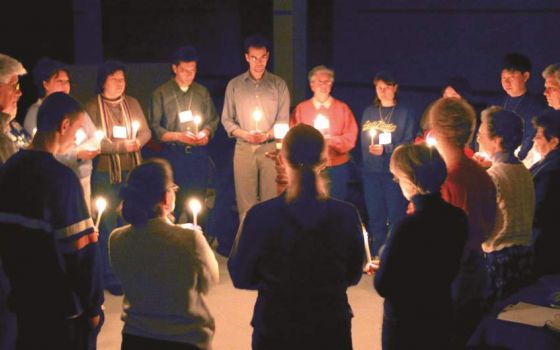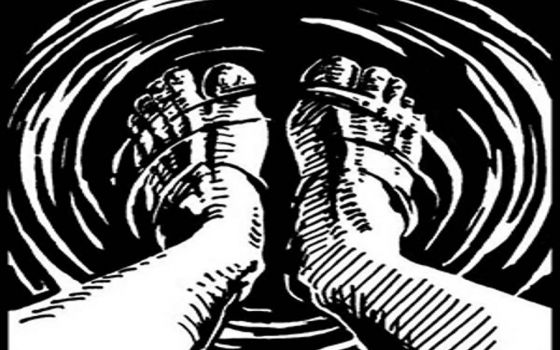
(Julie Lonneman)
Which way is transfiguration? Must I go through temptation to get there? How do I get from wilderness to garden, from cross to crown?
First of all, because the terrain is trackless and windswept, there is no conventional map. There are only signposts. We have to walk some of these lonesome valleys all by ourselves. So did Jesus.
And like Jesus, we can expect to be surprised at what we find. Did he know the devil was waiting for him in the desert? Did he know that one of his own would hand him over in the end? Do we really know what our Lenten journey might bring, what temptations we will face, or what lies in wait for us on the other side of conversion? But we are not without help.
Guidebook for the journey
In scripture, we read of Jesus' stories and write our own guidebook from them. We also orient ourselves with prayer. We agree to pay deep attention to the road instead of just gliding along. We look around. We see. We acknowledge where we are. In prayer, we ask God to guide us. The Lenten scriptures, superimposed on our own experiences, will keep us alert to the graces at work, even in moments of suffering, or when we go through, not around, sorrow.
Anyone can write a prayer. We write ourselves into the big cosmic stories, like the story of Lent that moves beyond temptation to transfiguration and beyond suffering to joy. We do so by paying attention to our ordinary experience. We choose what is most important out of the thousand things that happen in a day. Then we journal; we write down what happened. We reflect, and edit the language we used to describe what we have chosen to attend. Finally we say our prayer, ritualizing the saying of what we have written.
From journal entry to prayer
Imagine writing a journal entry like this: "Today, O God, I was tempted to skate right by that man on the subway who asked me for change. No, I did not give him change. But, still, I pray for his change and my change and our change. I was tempted not to care. I do care. I care about more than pocket change: I care about real change for him and for me, for us and for them. I care about not thinking about them and us any more. I am so tempted not to care. Can you turn this stone into bread? Amen."
You can take all of those thoughts and feelings and turn them into a one-sentence prayer: "For genuine change, not just pocket change, move me, O God." You probably have been tempted not to care today. Write about it.
What we write reveals us to ourselves, shows us who we are in how we feel, how we respond to others, what we do.
Tomorrow may be clear and uncluttered, open and spacious. Your description of the day can turn into a prayer like this: "For open space and a sense of being clear, hear my thanks, O God."
Prayers of gratitude
Many prayers during Lent and beyond are prayers of thanksgiving. Perhaps you are hurrying through a chaotic day, full of false starts and wasted time. At first you might write:
"Thank you that I am here, now, in this wilderness, lost on this way — yet confident that this suffering won't last. Note, O God, that I know that everything is going to be OK. Note that we live from the resurrection backward and that we fully believe weeping endures for the night and joy comes in the morning. Thank you, God, for showing me that Jesus rose from sorrow on the cross into joy. Show me again today. Amen."
After a little editing, this could become: "Oh God, show me why I hurry." Lent slows us down, gets us back in touch with ourselves, with the road we are on.
Writing something down makes it real, like the signature on a check. It frames our experience and helps us examine it more closely, pray over it deliberately, reflectively. Why do I turn away from strangers in need? Why am I in chaos again today? Have I stopped to enjoy today, say thank you? Why do I miss the prayers begging to be said in so many ordinary experiences?
Too deep for words
Of course, we can pray the kinds of prayers that are too deep for words or even sighs. If we hear a train has jumped the track and killed a baby, we say simply, "Oh, my God" — an inarticulate prayer, a good prayer. But more disciplined praying requires a little more reflection. When we write it down, we can edit it. And in the editing process, we ask the question, "What does this mean?"
Editing a prayer is not just editing language. It is also editing the concept. What is it I really want? Good friends don't just give us what we think we want; they help us to see what we need. Editing our desires after we have written them down can be a profoundly spiritual experience. Paying attention, choosing the transformation that matters — these lead directly to the poetry of the prayer.
Spend a lot of time choosing the right verb. The verbs in a prayer activate the conversation. They are the "what we want" part of the prayer: move me, show me, hear my thanks.
Advertisement
Ready to pray
After we have written a short prayer and edited it, we are ready to pray it. Some prayers need constant repetition, like the Our Father or Psalm 23. Others are sui generis; they are from today's focus, and for today.
I once asked a man who seemed very happy to explain himself to me. He said, "I am open to people, open to God. I'm not really much at all." It sounded like a prayer to me. I prayed later that day, "Let me be open to people and open to God, let me stop trying so hard to be anything more."
Lent is 40 days on purpose. It's a kind of prompt to notice life and not to rush through it. Lent can slow us down so that we actually experience what we suffer. When we write a prayer, we go toward the vortex of the tension we suffer inside. During this Lent, we may want to accept that some of the journey is through, not around, sorrow. Whatever we experience is what we will pray about. We can superimpose our lives on the guidebook of scripture, and then pray our way to reorientation and depth.
On to Easter
Attend, choose, write, edit, repeat: Think of it as the five-point guide to writing prayers out of ordinary life. These steps first get us in touch with our selves. Then these steps pull the big spiritual balloon of Lent down to earth.
A bit like a global positioning device, prayer routes us through the scriptural story of Lent to its other side, to Easter morning.
Editor's note: This reflection was originally published in the February 2008 issue of Celebration. Sign up to receive daily Lenten reflections.








